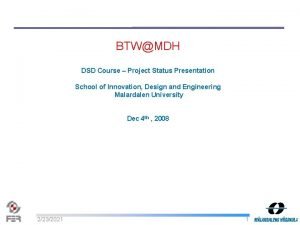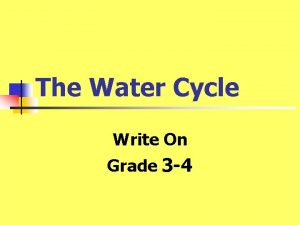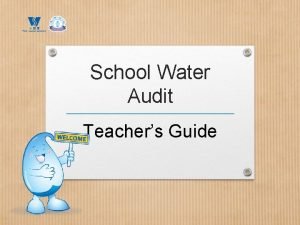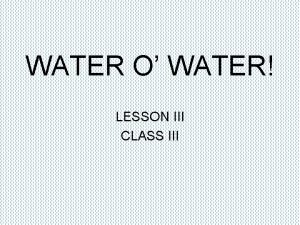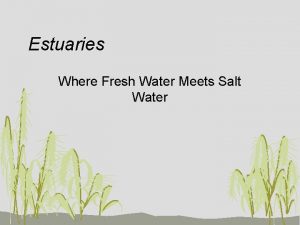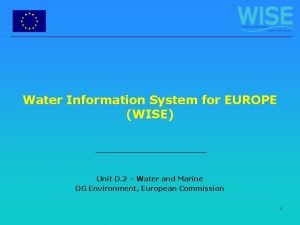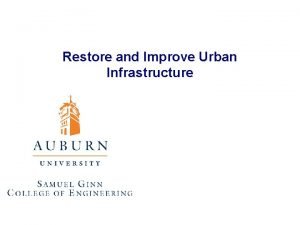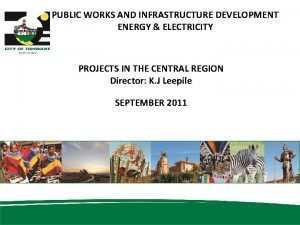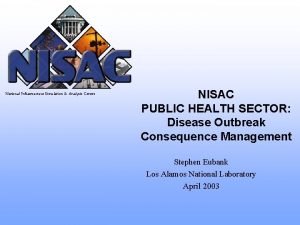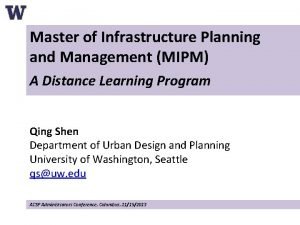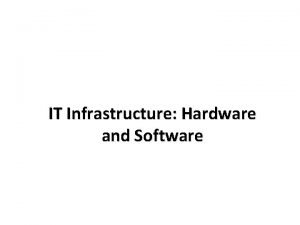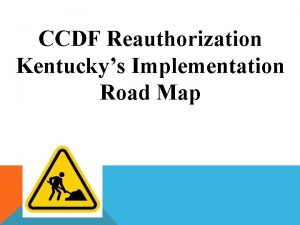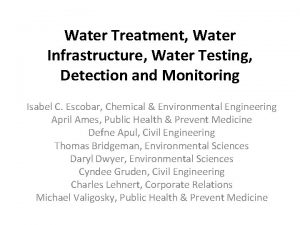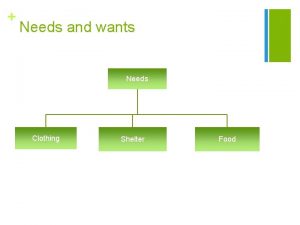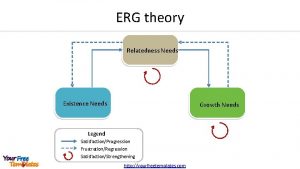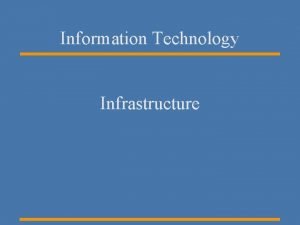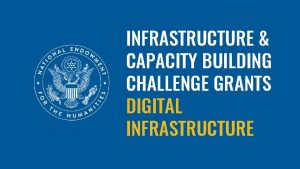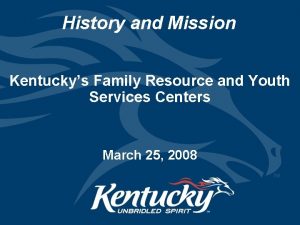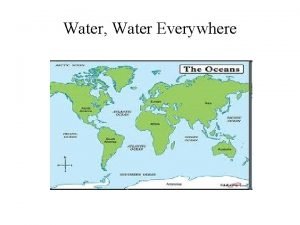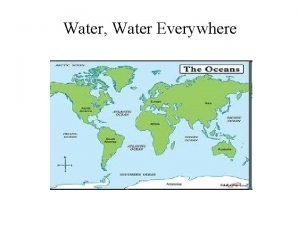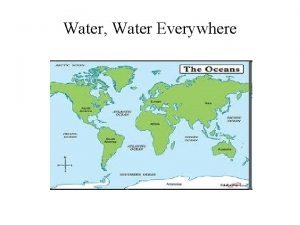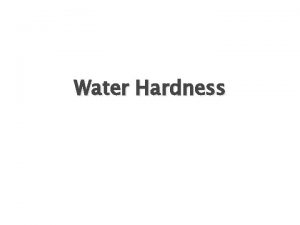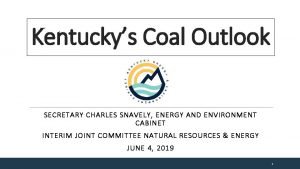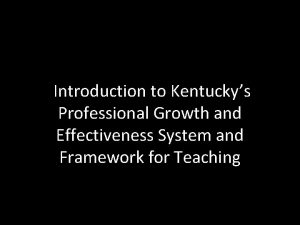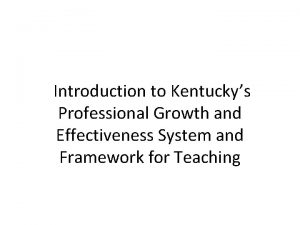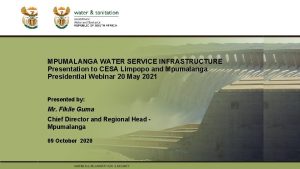Kentuckys Water Infrastructure Status and Needs Presentation to





























- Slides: 29

“Kentucky’s Water Infrastructure - Status and Needs” Presentation to: “Public Water and Wastewater System Infrastructure Task Force” Energy & Environment Cabinet (EEC) R. Bruce Scott, Deputy Secretary, EEC Pete Goodmann, Director, Division of Water July 24, 2019

Kentucky’s Water Infrastructure § Water is the top Natural Resource: – Critical to Kentucky’s success: • Public Health • Economic Development • Economic and Environmental Sustainability • Quality of Life § Water infrastructure (WTPs, WWTPs, distribution systems, collection systems) is critical to the health and economic welfare of the state. § We will focus on two infrastructure areas today: Wastewater and Drinking Water.

Kentucky’s Water Infrastructure § Kentucky has made significant strides in regards to water and wastewater: – Regionalization/Consolidation of Water and Wastewater Systems: • 95+% of Kentuckians provided public water. • Majority of Kentuckians connected to regional sewers. – Extensive Infrastructure. – Investment in Infrastructure: • Current investment isn’t sufficient to meet needs. • Consolidation of systems still ongoing to relieve unsustainable situations, but these consolidations come with old infrastructure where maintenance has been deferred and new investment is necessary.

Kentucky’s Water Infrastructure – Technical, Operations, and Compliance records are generally good, but there still remain significant challenges, especially related to infrastructure. – Kentucky has compiled extensive data on its water and wastewater infrastructure unsurpassed by any state: • Data that is able to be used for funding decisions, asset management, planning, etc. • We are positioned to improve the long-term management of our infrastructure.

Wastewater: Regionalization Success § Louisville Metropolitan Sewer District (MSD) is the largest wastewater utility in the Commonwealth and has regionalized the most facilities. Since 1996, more than 145 small WWTPs have been taken off-line. § While hundreds of small WWTPs across the Commonwealth have been regionalized, hundreds of wastewater systems are still in operation today. Approximately 180 have been identified as priority candidates for regionalization – challenging situations. § Passage of House Bill 513 in the 2018 General Assembly allows better regulatory oversight of small private WWTPS and allows Sanitation Districts, Water Districts, JSAs, etc. to own and operate systems outside jurisdiction with voluntary agreement.

Wastewater: Sanitary WWTPs

Wastewater: Compliance History

Wastewater: Needs & Challenges § Despite and because of Kentucky’s successful record of regionalization and proactively seeking regional solutions, there remain challenges. § We must invest in the assets we have built and maintain those assets or risk stranding previous asset investments and the communities they serve will be at real risk. § The challenges we face are largely about three major issues: – Age of Infrastructure. – Deferred Maintenance and Investment in that Infrastructure. – Insufficient Proactive Planning for the Future.

Wastewater: Rating Index Infrastructure Age

Wastewater: Rating Index Future Planning

Wastewater: Infrastructure Overview § Wastewater: – Approximately 800 wastewater treatment plants: • (average > 36 years) – Approximately 18, 000 miles of sewer line: • (average ~42 years) – Greater than 4000 sewage lift stations.

Wastewater: Infrastructure Funding Needs § Wastewater: – $6. 232 B in investment needs through 2035 (EPA 2014 Clean Watersheds Needs Survey): • Collection Systems including I/I, Replacement & Rehab and New Sewers = $3. 92 Billion. • Treatment, Both Secondary and Advanced = $1. 30 B. • CSO Abatement, including Green Infrastructure = $945 Million. • Stormwater Infrastructure = $67 Million. • Total = $6. 232 Billion. – Kentucky Grade = D+ • (2017 ASCE Infrastructure Report Card).

Drinking Water: # PWS & % Population Served 2500 2000 # PWS COMMUNITY NTNC 1974 2178 868 252 1058 1979 1812 755 252 805 1989 1254 639 215 400 1999 781 497 85 199 2009 484 409 26 49 2016 432 389 16 27 % Population Served by PWS 96 94 92 90 88 86 84 82 80 23 6/ 6/ 21 /1 90 1500 YEAR 5 12 /1 : 0 9 05 0: 0 6/ 25 12 0 A /1 M : 0 9 0: 0 6/ 27 5 1 00 A 2: /1 M 0 6/ 905 0: 0 29 12 0 A /1 M : 0 9 0 7/ 05 1 : 00 1/ A 19 2: 00 M 7/ 05 1 : 00 3/ AM 19 2: 00 7/ 05 1 : 00 5/ A 19 2: 00 M 7/ 05 1 : 00 7/ A 19 2: 00 M 05 : 0 12 0 A M : 0 0: 00 AM # PWS by Type 1000 500 0 1974 1979 1989 # PWS COMMUNITY 1999 NTNC 2009 2014

Drinking Water: Public Water Supply Coverage Areas not served by PWS

Drinking Water: Compliance History Public Water System Violation Trends 2007 -2018 1000 900 800 700 600 500 400 300 200 100 0 2007 2008 2009 2010 2011 Health-based 2012 2013 2014 2015 Monitoring & Reporting 2016 2017 2018

Drinking Water: Needs & Challenges § Despite and because of Kentucky’s successful record of regionalization and proactively seeking regional solutions, there remain challenges. § We must invest in the assets we have built and maintain those assets or risk stranding previous asset investments and the communities they serve will be at real risk. § The challenges we face are largely about three major issues: – Age of Infrastructure. – Deferred Maintenance and Investment in that Infrastructure. – Insufficient Proactive Planning for the Future.

Drinking Water: Rating Index Infrastructure Age

Drinking Water: Rating Index Future Planning

Drinking Water statistics § Drinking Water facts: – Kentucky uses an estimated 136 billion gallons of potable water each year – an estimated 75% of which is used by residential households. – The average per capita usage is typically less than 75 gallons per day (gpd), approximately 27, 000 gallons per year. – Greater than 95% of Kentucky households and businesses are served by a Public Water System (PWS) – consequently the vast majority of entities/individuals in Kentucky are currently paying ‘something’ for their water usage via an existing billing system. – There a variety of usage fee rate structure approaches that exist.

Drinking Water: Infrastructure Overview § Drinking Water: – 213 water treatment plants: • (average > 38 years) – Approximately 64, 000 miles of distribution lines: • (average ~40 years; 16% are > 50 years) • Challenges with terrain, depths, stream crossings, etc. – Approximately 1800 water storage tanks: • (average ~28 years) • Greater than 1000 pumping stations: • Many old, no redundancy, no redundant power.

Drinking Water: Funding Needs § Drinking Water: – $8. 2 B in need through 2035 (EPA’s 2015 needs survey): • Transmission and Distribution = $6, 320. 7 million. • Treatment = $929. 6 Million. • Storage = $648. 8 Million. • Source = $206. 7 Million. • Other = $126. 2 Million. • Total = $8. 232 Billion. – Kentucky Grade = D • (2017 ASCE Infrastructure Report Card)

Overview Of Investment Needs § Wastewater: $6. 232 Billion over the next 20 years. § Drinking Water: $8. 232 Billion over the next 20 years. § Why must we invest? – Without investment, Kentucky will increasingly experience failure of systems and experience detrimental environmental and quality of life impacts to communities and the Commonwealth in addition to losing economic growth opportunities. § Investment must occur, the only question is when? – Reactive approach: • Unplanned, emergency funding. • More expensive. – Proactive approach: • Planned investment and progressive asset management. • Sustainable and resilient. • Lowest cost approach.

What Are The Existing Funding Options? § Federal: – Kentucky Infrastructure Authority (KIA) State Revolving Fund (SRF) • Leveraged bonds – Rural Development Loans – Community Development Block Grants – Appalachian Regional Commission grants – Abandoned Mine Land grants § State: – General Funds – Tobacco Settlement funds – Coal Severance funds – State owned dam repair (SODR) funds § Local: – General Funds – Bond issuances – Water and Sewer rate revenue § Private: – P 3 investment – Privatization

KIA State Revolving Fund (SRF) § Capitalization Grant 2019 Funding Cycle: CW SRF - $20, 428, 000 DW SRF - $18, 303, 000 2018 Funding Cycle: CW SRF - $16, 874, 000 DW SRF - $12, 830, 000 2017 Funding Cycle: CW SRF - $17, 005, 000 DW SRF - $12, 941, 000 § SRF Funds Available for Lending 2019 Funding Cycle: CW SRF - $72, 000 DW SRF - $50, 000 2018 Funding Cycle: CW SRF - $50, 000 DW SRF - $22, 500, 000 2017 Funding Cycle: CW SRF - $135, 000 DW SRF - $34, 000 2016 Funding Cycle: CW SRF - $85, 000 DW SRF - $31, 500, 000 2015 Funding Cycle: CW SRF - $95, 868, 200 DW SRF - $32, 550, 112

Are There Funding Gaps? § Are we meeting the funding needs for all systems, and, are all of our systems availing themselves to the currently available funding options? – No. While there are many viable funding options, all needs are not being met and not all systems are taking advantage of or able to take advantage of the currently available options. – Why? Often, smaller, more vulnerable systems (public and private) have: • Inadequate fee rate structure in place to be sustainable. • Insufficient borrowing capacity to obtain low or even zero interest loans to address their needs. • Inadequate technical capacity to sufficiently operate the system(s). • Difficult to find entities willing to inherit or assume the responsibility and challenges of managing a substandard or poorly operating system.

What Is Needed? § Targeted investment in Kentucky’s critical water infrastructure where existing funding options are limited in challenged communities: - Water and wastewater treatment, collection, and distribution. - Drinking water sources. § Develop Community Partnerships: - Making financing infrastructure more available and affordable for communities. - Complementing and leveraging existing sources of funding. • SRFs, FEMA HMGP, HUD CDBG, Rural Development, DHS, EPA § 319(h), AML, ARC - Public / Private Partnerships: • P 3 water projects • Privatization

Other Challenges § Some systems lack Technical, Managerial, and Financial capacity § Some systems are not sufficiently doing long-term strategic planning: ― systems need to be self sustaining ― some systems may be too reliant on expecting help from others outside of their system § Some systems are understaffed with certified operators (underpaid, cannot qualify) § Need better cost accounting and financial oversight, better asset management, and may require additional regulatory oversight. § 2018 HB 513 has been successful (Crestwood, others, …) in allowing voluntary interlocal agreements between public entities. § Need to enhance ability for private investment in providing public services.

Benefits § Kentucky wins by investing in its infrastructure: – Economic sustainability and resilience of water and wastewater systems. – Provide a catalyst for economic development: • Balance the sustainability of the state and small communities in Kentucky with economic development opportunities. – Protecting Kentucky: • Public Health. • Environmental and Economic Sustainability. • Economic Development / Growth. • Quality of Life. – Create permanent jobs every year in Kentucky. * * For every $1 million invested in water infrastructure, 15 jobs are created (Economic Benefits of Investing in Water Infrastructure, EPA).

Moving Forward § Establishment of this Water and Wastewater System Infrastructure Task Force. § Develop possible options and solutions. § Report to the General Assembly with recommendations. § Remember – it isn’t if we have to make these investments, rather it is when we make them. We are either going to be reactive or proactive.
 Water and water and water water
Water and water and water water Primary needs and secondary needs
Primary needs and secondary needs Primary needs and secondary needs
Primary needs and secondary needs Alpha press murray
Alpha press murray Strategic gender needs and practical gender needs
Strategic gender needs and practical gender needs Target need analysis
Target need analysis Project status presentation
Project status presentation Vertex presentation and cephalic presentation
Vertex presentation and cephalic presentation 4 maneuvers of leopold
4 maneuvers of leopold What is fresh water allowance
What is fresh water allowance Water cycle grade 3
Water cycle grade 3 Chapter 5 diversity and human needs and development
Chapter 5 diversity and human needs and development Unstated needs in travel and tourism
Unstated needs in travel and tourism Drinking fountain
Drinking fountain Water o water
Water o water Estimating products of fractions
Estimating products of fractions A paved blacktop parking lot was built
A paved blacktop parking lot was built Water heat exchanger
Water heat exchanger Fresh water meets salt water
Fresh water meets salt water Warm water rises in a lake. cold water descends.
Warm water rises in a lake. cold water descends. Water water everywhere project
Water water everywhere project Imp of water resources
Imp of water resources Unit 11 water water everywhere
Unit 11 water water everywhere Ways to improve urban infrastructure
Ways to improve urban infrastructure Gomsand substation
Gomsand substation Mutable vs immutable infrastructure
Mutable vs immutable infrastructure Nisac
Nisac Mcse private cloud
Mcse private cloud Masters in infrastructure planning and management
Masters in infrastructure planning and management Computer hardware platforms in it infrastructure
Computer hardware platforms in it infrastructure






